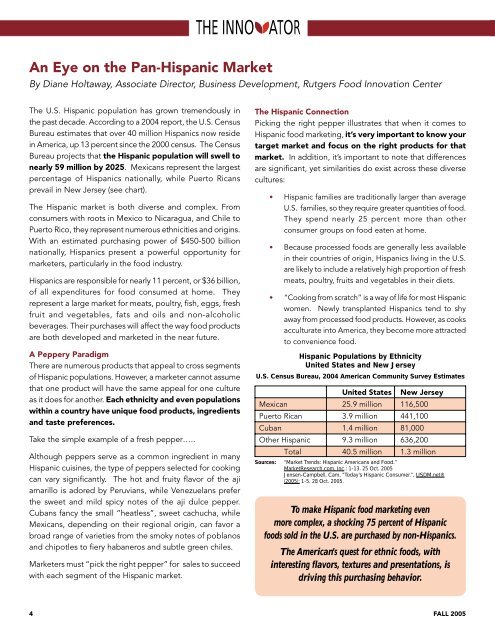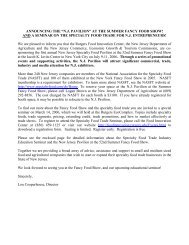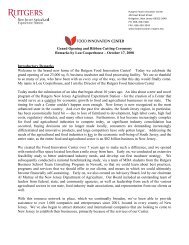THE INNO ATOR - Rutgers Food Innovation Center
THE INNO ATOR - Rutgers Food Innovation Center
THE INNO ATOR - Rutgers Food Innovation Center
Create successful ePaper yourself
Turn your PDF publications into a flip-book with our unique Google optimized e-Paper software.
<strong>THE</strong> <strong>INNO</strong><br />
<strong>ATOR</strong><br />
An Eye on the Pan-Hispanic Market<br />
By Diane Holtaway, Associate Director, Business Development, <strong>Rutgers</strong> <strong>Food</strong> <strong>Innovation</strong> <strong>Center</strong><br />
The U.S. Hispanic population has grown tremendously in<br />
the past decade. According to a 2004 report, the U.S. Census<br />
Bureau estimates that over 40 million Hispanics now reside<br />
in America, up 13 percent since the 2000 census. The Census<br />
Bureau projects that the Hispanic population will swell to<br />
nearly 59 million by 2025. Mexicans represent the largest<br />
percentage of Hispanics nationally, while Puerto Ricans<br />
prevail in New Jersey (see chart).<br />
The Hispanic market is both diverse and complex. From<br />
consumers with roots in Mexico to Nicaragua, and Chile to<br />
Puerto Rico, they represent numerous ethnicities and origins.<br />
With an estimated purchasing power of $450-500 billion<br />
nationally, Hispanics present a powerful opportunity for<br />
marketers, particularly in the food industry.<br />
Hispanics are responsible for nearly 11 percent, or $36 billion,<br />
of all expenditures for food consumed at home. They<br />
represent a large market for meats, poultry, fish, eggs, fresh<br />
fruit and vegetables, fats and oils and non-alcoholic<br />
beverages. Their purchases will affect the way food products<br />
are both developed and marketed in the near future.<br />
A Peppery Paradigm<br />
There are numerous products that appeal to cross segments<br />
of Hispanic populations. However, a marketer cannot assume<br />
that one product will have the same appeal for one culture<br />
as it does for another. Each ethnicity and even populations<br />
within a country have unique food products, ingredients<br />
and taste preferences.<br />
Take the simple example of a fresh pepper…..<br />
Although peppers serve as a common ingredient in many<br />
Hispanic cuisines, the type of peppers selected for cooking<br />
can vary significantly. The hot and fruity flavor of the aji<br />
amarillo is adored by Peruvians, while Venezuelans prefer<br />
the sweet and mild spicy notes of the aji dulce pepper.<br />
Cubans fancy the small “heatless”, sweet cachucha, while<br />
Mexicans, depending on their regional origin, can favor a<br />
broad range of varieties from the smoky notes of poblanos<br />
and chipotles to fiery habaneros and subtle green chiles.<br />
Marketers must “pick the right pepper” for sales to succeed<br />
with each segment of the Hispanic market.<br />
The Hispanic Connection<br />
Picking the right pepper illustrates that when it comes to<br />
Hispanic food marketing, it’s very important to know your<br />
target market and focus on the right products for that<br />
market. In addition, it’s important to note that differences<br />
are significant, yet similarities do exist across these diverse<br />
cultures:<br />
• Hispanic families are traditionally larger than average<br />
U.S. families, so they require greater quantities of food.<br />
They spend nearly 25 percent more than other<br />
consumer groups on food eaten at home.<br />
• Because processed foods are generally less available<br />
in their countries of origin, Hispanics living in the U.S.<br />
are likely to include a relatively high proportion of fresh<br />
meats, poultry, fruits and vegetables in their diets.<br />
• “Cooking from scratch” is a way of life for most Hispanic<br />
women. Newly transplanted Hispanics tend to shy<br />
away from processed food products. However, as cooks<br />
acculturate into America, they become more attracted<br />
to convenience food.<br />
Hispanic Populations by Ethnicity<br />
United States and New Jersey<br />
U.S. Census Bureau, 2004 American Community Survey Estimates<br />
United States New Jersey<br />
Mexican 25.9 million 116,500<br />
Puerto Rican 3.9 million 441,100<br />
Cuban 1.4 million 81,000<br />
Other Hispanic 9.3 million 636,200<br />
Total 40.5 million 1.3 million<br />
Sources:<br />
“Market Trends: Hispanic Americans and <strong>Food</strong>.”<br />
MarketResearch.com, Inc.: 1-13. 25 Oct. 2005<br />
Jensen-Campbell, Cam, “Today’s Hispanic Consumer.”, USDM.net®<br />
(2005): 1-5. 28 Oct. 2005.<br />
To make Hispanic food marketing even<br />
more complex, a shocking 75 percent of Hispanic<br />
foods sold in the U.S. are purchased by non-Hispanics.<br />
The American’s quest for ethnic foods, with<br />
interesting flavors, textures and presentations, is<br />
driving this purchasing behavior.<br />
4 FALL 2005







